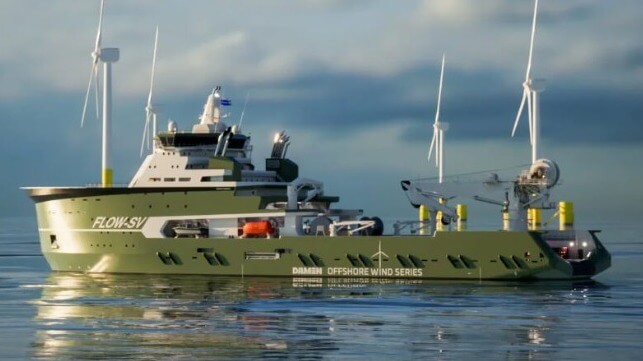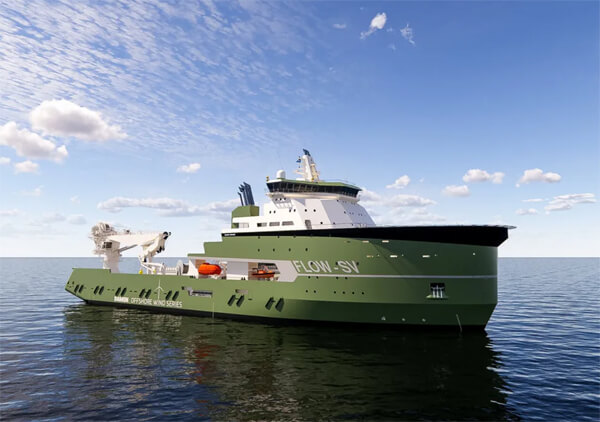Damen Designs Vessel Concept Tailored to Floating Offshore Wind Farms

The growth of the offshore wind sector is creating demand for shipbuilding and new types of vessels with unique capabilities to support the industry’s growth. Anticipating upcoming large-scale floating wind farm installations, Damen has developed the FLOW-SV vessel specially designed to install offshore floating turbines. The shipbuilding reports that its analysis shows the need for new vessels tailored specifically to the challenges of installing the floaters.
Damen reports its design, which is in the concept stage, is for a larger vessel than the current anchor handling class. Their concept is for a vessel that can load the immense lengths of chain needed to install and secure floaters. To speed up the work the FLOW-SV would have the capability to handle up to three anchors at one time.
“With the FLOW-SV, we have developed a vessel which covers the entire process of attaching mooring lines. This vessel, combining the supply, installation, securing, and inspection of the ground tackles for floating turbines in one vessel, introduces a big step forward toward large-scale installation of floating windfarms,” says Wijtze van der Leij, Sales Manager at Damen.
Measuring approximately 492 feet in length and approximately a 105-foot beam, the FLOW-SV is a big ship. The size and weight of anchors and chains needed for installing offshore floating wind turbines are so big says Damen that a larger vessel is needed than traditional anchor handling vessels. When Damen engineers defined the amounts of gear that the FLOW-SV would need to take on board to be able to install three floaters in a base case of over 300 feet water depth, their calculations added up over three miles of chain along with nine anchors each weighing 15 tons and almost 100 clump weights of 10 tons each. All the gear they estimated could exceed 4,000 tons for the vessel to move to the site.

In their concept, the FLOW-SV has unique capabilities to handle these loads and the challenges of the installation. Two fixed propellers in nozzles and two azimuthing thrusters at the stern propel the FLOW-SV and provide forward bollard pull. The azimuthing thrusters are also engaged for dynamic positioning, together with the retractable azimuthing thruster and tunnel thrusters in the bow section of the vessel. To address environmental concerns, they envision the vessel fueled with methanol.
The FLOW-SV would deploy its bow anchor and embed it by reversed bollard pull. She then moves to the spot where the anchor for the floater needs to be installed. The vessel has large winches on the forward end of the large open aft deck, a 250-ton crane, two smaller cargo rail cranes for handling gear on deck, and a triple drum anchor winch that can deploy 600 tons of pulling force.
The vessel is also outfitted to support two working-class ROVs, including a moonpool to launch submarine vehicles in the middle of the vessel. The ROVs would be used for sea bottom inspection to determine the best spot to install the anchor. After installing the anchors for the turbine floater, the ROVs can be deployed for inspection of the anchor and to see if it has dug in to provide a secure ground connection.
In the next phase of the development, Damen is looking for a partner that would be involved in refining the design concept for the new vessel class. They anticipate that as many as 100 vessels of this type might be needed to carry out the planned wind farm development.
